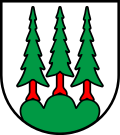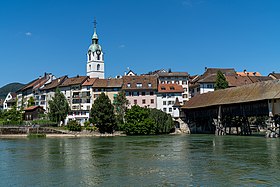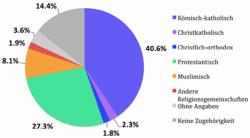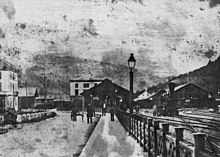Olten
| Olten | |
|---|---|
| State : |
|
| Canton : |
|
| District : | Olten |
| BFS no. : | 2581 |
| Postal code : | 4600 |
| UN / LOCODE : | CH OLT |
| Coordinates : | 635 447 / 244826 |
| Height : | 396 m above sea level M. |
| Height range : | 380–691 m above sea level M. |
| Area : | 11.49 km² |
| Residents: | 18,363 (December 31, 2018) |
| Population density : | 1598 inhabitants per km² |
| City President : | Martin Wey ( CVP ) |
| Website: | www.olten.ch |
|
Old town with wooden bridge |
|
| Location of the municipality | |
Olten is a city, political municipality and the capital of the district of the same name in the canton of Solothurn in Switzerland . Olten is the largest city in the canton and, as an important rail hub in Switzerland, it is a railroad town between the major cities of Zurich , Basel and Bern .
geography
Olten is located in a basin on both sides of the Aare at the southern foot of the Jura , between the southernmost chain of the folded Jura and the upstream range of hills Born , Engelberg and Säli , the latter being the local mountain of Olten. In the south, the half of the large Aareklus between Born and Säli, the Ruttigertal , and the area of Ruppoldingen south of the Born belong to the municipality. Between the Born and the Jura slope lies the north-eastern end of the Gäu Plain with the Dünnern in the area of the city of Olten.
The community area covers an area of 1149 hectares; 457 hectares (40%) of which are forested.
Neighboring communities of Olten are Boningen , Kappel (SO) and Wangen bei Olten in the west of the city, Trimbach and Winznau in the north, Starrkirch-Wil and Dulliken in the east and the Aargau communities Aarburg and Rothrist in the south.
coat of arms
Blazon :
- In white on a green three mountain three red-stemmed green fir trees
A high medieval coat of arms of Olten is not known. As a country town in the territory of the city of Basel, Olten has had the symbol of the Basel staff in its coat of arms since the late 14th century . The new seal used around 1580 showed three box trees. After the Peasants' War in 1653, the city of Solothurn withdrew the right to certify documents with this seal from the subject city of Olten. The coat of arms with three fir trees was used at the latest since then. In the Helvetic Republic, the city of Olten received the right to seal back around 1800. Since then, the new seal with three fir trees has also applied to the city of Olten.
population
| Population development | ||||||||
|---|---|---|---|---|---|---|---|---|
| year | Around 1660 | 1739 | 1798 | 1850 | 1900 | 1950 | 1970 | 2000 |
| Residents | 500 approx. | 888 | 1223 | 1634 | 6969 | 16485 | 21209 | 16757 |

The population of Olten declined towards the end of the 20th century, from once more than 20,000 to almost 17,000 in the meantime, due to deindustrialization , but also to the suburbanization process common in urban regions . In recent years the city's population has increased again and is now over 19,000. The implementation of the Olten SüdWest development project is expected to add two to three thousand new residents. A good 100,000 people in 26 municipalities (Amtei Olten-Gösgen) live in the Olten agglomeration .
In the census of December 2000, a foreigner share of 26% was determined, the largest share being Italians and citizens of the former Yugoslavia.
The population of Olten used to be predominantly Roman Catholic . Due to immigration from the rest of Switzerland, the proportion of people of the Roman Catholic denomination decreased and in December 2004 was 41%. They were followed by the Reformed with a share of 26%. 12% of the people of Olten have no denomination.
Although the Christian Catholics make up only 2% of the population, Olten is of great importance for the Christian Catholic Church: The first Christian Catholic congregation in Switzerland, founded by Walther Munzinger from Olten, came into being in the town church ; In 1875 the first national synod of the Christian Catholic Church took place in Olten, the Olten pastor Eduard Herzog was elected the first Christian Catholic bishop in 1876. Olten still has one of the largest Christian Catholic parishes in Switzerland today.
On the border with Trimbach there is a community of the Association of Apostolic Christians and at the same time the Swiss administration of the community.
language
In Olten, a north-west Swiss dialect is traditionally spoken, which is already clearly different from the city- Solothurn dialect . It contains similarities with dialects from the Bern area, the Basel area and the Aargau dialect, which is already close to the Zurich dialect. In this respect, the central location between the major centers of German-speaking Switzerland is also reflected in the language.
The term "Bahnhofbuffet-Olten-Dialekt" does not refer to the Olten dialect, but jokingly refers to a Swiss - German everyday dialect that no longer has a particular regional origin - named after the place where German-speaking Swiss from all regions often meet (see Bahnhofbuffet Olten and the lower section of traffic ).
traffic
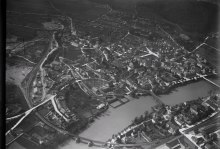
As an important railway junction, Olten is a typical railway town . The spacious railway facilities of the Olten station are to the east of the Aare. The north-south axis Basel - Milan ( Hauenstein line , Gotthard railway ), the west-east axis Geneva - St. Gallen ( railway line Olten – Bern , Jurasüdfusslinie ) and some regional lines meet in the city. The large, representative station in an island location from 1903 with a platform hall is a hub station in the SBB system , i. H. always on the hour and half hour strike from all directions one the trains. This allows travelers to transfer quickly and easily. Railway operations are monitored by dispatchers in the operations center (BZ) Mitte , which is clearly visible next to the platform systems. The central operations center, which went into operation on March 1, 2015, will direct train traffic to the northern Gotthard and Simplon feeders as well as SBB's west-east traffic. The SBB also maintain a marshalling yard at this central point in the network north of the passenger station , which is comparatively small, has had no drainage mountain since 1927 and on which no train dismantling has taken place since 2008, as well as several maintenance companies, including the large SBB industrial plant, formerly called the «main workshop». In spring 2011, SBB Cargo International moved into its headquarters in Olten near the train station.
The A1 motorway runs south of the city from Zurich to Bern, and in the west the A2 motorway runs through the Belchentunnel to Basel. Olten suffers from through traffic. During the rush hour there are regular traffic jams on the access roads and in the city center. In 2013 a large bypass (“Relief Region Olten”) was opened; it should reduce the traffic through the city center.
The bus company Olten Gösgen Gäu (BOGG) maintains a dense bus network in and around the city. Swiss Post operates a PostBus line to Wolfwil and Oensingen .
politics
Municipal Parliament (Legislative)
The concerns of the population are represented by the municipal parliament. It consists of 40 members (50 members until the 2017 election) and is elected every four years using proportional representation. The diagram opposite shows the distribution of seats after the election on April 23, 2017.
* Before 2017: 50 seats in total |
City Council (Executive)
The city council of Olten consists of a city president in full office and four members in secondary office. The members are elected by majority vote.
The five city councils for the August 2017-2021 legislative period are:
- Martin Wey (CVP), mayor
- Thomas Marbet (SP)
- Benvenuto Savoldelli (FDP)
- Marion Rauber (SP)
- Iris Schelbert (Greens)
National elections
In the 2019 Swiss parliamentary elections, the share of the vote in Olten was: SP 26.2%, Greens 20.1%, SVP 16.1%, FDP 15.8%, glp 8.7%, CVP 8.3%, EPP 1, 8%, BDP 1.7%.
Town twinning
Olten has city partnerships with:
- Altenburg , Thuringia ( Germany )
- Stierva , Canton of Graubünden (Switzerland); The former municipality of Stierva was merged with other municipalities in the district of Alvaschein in the new municipality of Albula / Alvra due to a referendum at the beginning of 2015 .
education
Olten is an important educational location. In the city are the University of Applied Sciences Northwestern Switzerland with the areas of economics, applied psychology, social work and the Institute for Optometry (part of the University of Technology), the Vocational Training Center Olten, the Cantonal School Olten and the curative education school center hpsz . There are also numerous private schools.
A city library is available to the population. The Solothurn Central Library can be used for an even wider selection .
The Olten School Festival has been celebrated every two years since 1816, on the weekend before the start of the summer holidays, today in the odd years, with a big parade on Sunday.
Healthcare
The Olten Cantonal Hospital was opened in 1880. In the 1960s, a new building by the architects Frey and Schindler was built, and in 1995 a longer renovation and new construction phase began, which was completed in 2012. The cantonal hospital has been part of Solothurner Spitäler AG since 2006 .
Culture
theatre
The Olten City Theater is the main venue of the Olten Cabaret Days every year . Olten also has some small theaters, e.g. B. the theater studio Olten .
Museums
There are four museums in Olten. These are the historical museum, the art museum and the nature museum of the city of Olten as well as the archaeological museum canton Solothurn. All four museums are located on the edge of Olten's old town near the city church.
The Olten Art Museum was opened in 1902 and is based on a collection of works by the famous Olten painter Martin Disteli . Until 1964 it was called the “Disteli Museum”; today it includes a collection of paintings and graphic sheets from the 19th century and a modern art section.
The other museums have been housed in the “House of Museums” since autumn 2019. It includes the Olten Nature Museum, the Olten History Museum and the Canton Solothurn Archaeological Museum. The museums are municipal or cantonal institutions. They work closely together, but are independent in the areas of collection, exhibition and communication. Thematically, the House of Museums focuses on archeology in the canton of Solothurn, the history of the city of Olten and the canton from its beginnings to the present day, and natural history and biodiversity at the local, regional and cantonal level.
The Olten Historical Museum was founded in 1902. Since 1932 it has shown its exhibitions in the then newly constructed multi-purpose building on Konradstrasse. The museum maintains extensive collections of cultural assets relating to the history of the city of Olten and other communities in the canton of Solothurn. It carries out mediation projects on city and cultural history. Aspects of the work behind the scenes are now regularly brought closer to a broad audience in the so-called “history workshop”. His collection includes large image archives of several Olten photographers, for example by Franz Gloor, Werner Rubin and Thomas Ledergerber as well as the Solothurn industrial photographer Roland Schneider. Some of these can be seen in the permanent exhibition.
Culture and city magazine KOLT
The Kolt Magazin appears 6 times a year and reports on the cultural life in Olten. The first issue appeared in October 2009.
Cultural event
The Olten Book Fair took place every November from 2006 to 2015 . The event was first held in 1946. For several years the book fair used the premises of the book center in Hägendorf, which had emerged from the Swiss club assortment founded in Olten in 1882 . The Olten Book Festival was launched in 2017 and has been taking place in November since then.
The Olten Dance Days , organized by the Tanzinolten Association, have also taken place in November since 1996 . They are dedicated to professional, contemporary dance in an international setting.
Since 2012, local cultural organizers have been organizing the 23 falling stars every December . From December 1st to December 23rd, a half-hour surprise event will be offered every day: music, dance, drama, cabaret, reading, film, etc. The concept means that the audience does not know in advance what is going to be shown that evening.
history
Early days
Early Stone Age cave settlements were found in the Säli caves , and the mammoth find from Olten is also associated with these settlements. Rich flint deposits in the chalofen were extracted and used in the area as raw material for tools .
Roman times
Numerous archaeological finds prove that an important settlement already existed on the plateau of the Olten city center in Roman times , the place name of which, however, is not recorded in any inscription. Because of the large number of Roman objects found in the late 19th century , the city gave the newly built district street north of the Capuchin monastery the street name Römerstrasse . In the area between the Aare and the Baslerstrasse was a small vicus , a Roman street village on the large thoroughfare between the city of Aventicum and the legionary camp of Vindonissa . Extensive ruins of Roman country houses from the first century AD came to light in the urban areas of Im Grund and Römerpark . In late antiquity, the Romans - as in Solothurn - built a strong fort to secure the river crossing , the surrounding wall of which served as the foundation of the city wall in the High Middle Ages.
middle Ages
Although an older settlement has been proven, the founding of Olten is attributed to the Counts of Frohburg . In the great fire of 1422, the total was unfortunately archive burned so that no documents from that time are no longer present.
In 1383, Olten was besieged by Bern and Solothurn , but due to a storm they had to leave without having achieved anything. They then spread the rumor that the storm was summoned by a witch. Shortly afterwards, a woman from the Klus was arrested as the " Witch of Olten" in Niederbipp . She escaped death by fire only at the intercession of the councilors' wives .
Due to the two devastating city fires of 1411 and 1422, the interest of the city of Basel died out , and in 1426 Olten came into the possession of the city of Solothurn as a pledge. In 1532 the rulership rights were transferred from the Bishop of Basel to the city of Solothurn for 1,800 guilders.
The plague broke out in 1611 and is said to have wiped out all but 14 citizens of Olten.
The support of the rebellious peasants cost the city all its political privileges in 1653 and made Olten an ordinary subject. It was not until November 12, 1800, when the Helvetic Republic handed over the town charter and seal that had been deposited in Solothurn since 1653 .
Modern times
Around 1850, Olten became the hub of the important Swiss railway lines and the city attracted the Swiss Central Railway with a generous offer. Even today, the kilometer zero stone reminds us that the entire Swiss rail network was measured from Olten.
The two world wars
In the area of the Hauenstein fortification (Wisenberg- Hauenstein-Ifenthal - Belchen ), a fortress system with a length of 50 km and over 150 gun emplacements was built during the First World War . The rear service was stationed in Olten with over 72,000 members of the army and 10,000 horses.
In 1918 the Olten Action Committee was set up by the leader of the Swiss labor movement, Robert Grimm . The general strike in Olten was peaceful.
During the Second World War , over 60,000 members of the army were billeted in Olten. In addition, there were over 18,000 refugees and internees in Olten. The Gheid airfield was occupied by a Messerschmitt squadron of five aircraft.
economy
Industry
The industrialization of the Olten region since the middle of the 19th century led to the establishment of many companies and branches:
- 1855 Central workshop of the Schweizerische Centralbahn SCB , later SBB main workshop in Olten, today SBB Industriewerk Olten
- 1866 von Roll foundry
- 1866 Strub and Glutz shoe factory
- 1868 Louis Giroud machine works
- 1869 Lamp factory Pfändler
- 1888 Dr. Richter AG
- 1898 Soap factory Helvetia, renamed Seifenfabrik Sunlight in 1909, Lever Brothers ' first continental European subsidiary
- 1901 Aluminum goods factory E. Pfaendler & Cie. (Pans and pots)
- 1903 R. Nussbaum AG
- 1904 Berna
- 1906 Glashütte Maetz and Sons
- 1911 Nago (nutrient works AG, Olten). Launched the instant cocoa drink Banago in 1927 . Taken over by Lindt & Sprüngli in 1971
- 1917 OLMA
Today Giroud-Olma AG still exists as a merger of the two above companies and R. Nussbaum AG.
media
Olten is the location of media companies such as B .:
- Dietschi AG , publisher of the Oltner Tagblatt
- Walter Verlag , taken over by Patmos Verlag in 1992
- The publishing house Schweizerisches Jugendschriftenwerk was founded in Olten in 1931.
Other companies (selection)
- Atel (Aare-Tessin Aktiengesellschaft für Elektrizität), merged with the Alpiq energy group in 2009 with headquarters in Lausanne and Olten
- Swiss Prime Site , real estate investment company
- Usego (Union of Swiss Purchasing Company Olten), retail company. After various mergers and acquisitions since the 1970s, liquidated as a legal entity in 2005. Striking business and warehouse on the Olten-Wangen railway line
- Alternative Bank Schweiz AG (ABS) , a credit institute whose goal is not to maximize profits, but to promote ecological and social projects
- Baugesellschaft Olten AG, former construction company
prostitution
For many years, Olten had the reputation of being home to the “longest street in Switzerland”. In a directive from 1992, the city council officially tolerated the two-kilometer-long Industriestrasse as a line zone. In October 2004 the city council decided to put an end to open prostitution in this area in order to provide a more pleasant environment for the existing companies and any new investors. Since the beginning of 2005, there has been a night driving ban between 8 p.m. and 5 a.m. on Industriestrasse. Prostitutes and clients are driven away with strict police controls. The strategy worked gradually.
Attractions
- The wooden bridge over the Aare, built by Blasius Balteschwiler in 1803 , leads from the Bahnhofsquai diagonally opposite the main train station directly into the old town with some interesting churches, old town houses and the city tower.
- The station buffet in Olten is known throughout Switzerland. Numerous important associations have been founded here, e. B. the Swiss literary group Olten and the Swiss Alpine Club SAC.
- The old town restaurant Rathskeller (popularly known as Chöbu ) stands out with its facade and the collection of weapons.
- Several hiking trails lead from Olten into the surrounding area, for example to the Frohburg or the Sälischlössli , which star chef Anton Mosimann briefly ran as a gourmet restaurant, but has since sold again. There are also several hiking trails along the banks of the Aare.
- The mountains of the Swiss Jura offer summit destinations in the immediate vicinity such as the Belchen (1123 m) with a panorama of the north-west Basel area and to the south of the Bernese Alps with the Eiger , Mönch and Jungfrau .
- The parish church of St. Marien is also remarkable , it was built according to plans by the architect Hermann Baur from Basel. A special feature is the tower in the form of a campanile , where there are four bells. The Gehr painting above the chancel is also noteworthy.
- The two bells from St. Martin and the Friedenskirche are worth mentioning. They each have a mighty zero octave bell as a large bell. Both chimes sound in A flat major.
- The Swiss Writer's Path was opened in 2016. The authors Franz Hohler , Alex Capus and Pedro Lenz are each dedicated to an audio tour with 8 locations each. In these places you can listen to stories with a smartphone using a QR code that were read out by the authors themselves. Works by other authors can be heard on a fourth tour.
Personalities
- Caroline Agnou (* 1996), track and field athlete
- Fabio Antoniali (* 1975), music producer, musician
- Umberto Arlati (1931–2015), jazz musician and music teacher
- Benedikt von Arx (1817–1875), notary, judge, politician
- Casimir von Arx (1852–1931), politician and first Chairman of the SBB Board of Directors
- Ildefons von Arx (1755–1833), Father of the St. Gallen Monastery, archivist and historian
- Blasius Balteschwiler (1752–1832), carpenter
- Ursula Berger (* 1950), dancer, dance teacher and choreographer
- Hanspeter Betschart (* 1951), theologian, Capuchin, pastor
- Peter André Bloch (* 1936), Germanist and university professor
- Albert Borer (1910–2004), commercial artist and advertising photographer
- Gustav von Burg (1871–1927), teacher, ornithologist and publicist
- Alex Capus (* 1961), writer
- Werner Nydegger (* 1945), cartoonist, graphic artist, painter, designer, sculptor
- Hans Derendinger (1920–1996), lawyer, editor, city administrator
- Eugen Dietschi-Kunz (1881–1951), printer and historian
- Peter Dietschi (1830–1907), editor, publisher, politician
- Martin Disteli (1802–1844), painter
- Maria Felchlin (1899–1987), campaigner for women's suffrage
- Thomas Frei (* 1985), professional cyclist
- Ernst Gaugler (1891–1963), Christian Catholic clergyman, theologian and professor
- Hans Gerny (* 1937), Christian Catholic bishop
- Arnold Gilg (1887–1967), Christian Catholic clergyman and professor
- Otto Gilg (1891–1976), Christian Catholic clergyman and church historian
- Franz Gloor (1948–2009), photographer
- Joris Gratwohl (* 1973), actor
- Marco Grob (* 1965), portrait fashion photographer
- Bernhard Hammer (1822–1907), Federal Councilor
- Adelheid Hanselmann (* 1946), artist
- Bruno Bernhard Heim (1911–2003), archbishop and heraldry
- Peter Heim (* 1944), historian, teacher and archivist
- Anna Heer (1863–1918), doctor and first president of the Nursing Association
- Eduard Herzog (1841–1924), theologian and Christian Catholic bishop
- Franz Hohler (* 1943), writer, cabaret artist and songwriter
- Gökhan Inler (* 1984), football player
- Ueli Jäggi (* 1954), actor and radio play speaker
- Eduard Kaeser (* 1948), physicist, philosopher, publicist
- Conny Kissling (* 1961), freestyle skier
- Walter Kräuchi (1913–1996), trade unionist, editor, politician
- Hermann Kull (1873–1961), mechanical and electrical engineer
- Michael Lauber (* 1965), Federal Prosecutor
- Denis Malgin (born 1997), ice hockey player
- Bruno Moll (* 1948), documentary filmmaker
- Mike Müller (* 1963), cabaret artist and actor
- Paul Hermann Müller (1899–1965), chemist, Nobel Prize in Medicine 1948
- Josef Munzinger (1791–1855), Federal Councilor
- Marie Munzinger (1885–1952), teacher and author of teaching materials
- Ulrich Munzinger (1787–1876), merchant, mayor
- Walther Munzinger (1830–1873), canon lawyer
- Werner Munzinger (1832–1875), Africa explorer
- Fritz von Niederhäusern (1876–1955), builder and architect
- Rudolf Peyer (1929–2017), writer
- Stefano Prada (* 1973), house DJ and producer
- Konrad Viktor Pressel (1857–1929), hydraulic engineer
- Ivana Rentsch (* 1974), musicologist and university lecturer
- Niklaus Riggenbach (1817–1899), inventor of the rack railway system
- Christof Schelbert (* 1956), artist and university professor
- Guido Schmezer (1924–2019), writer
- Karl Schmid (1827–1909) bookseller, founder of the club range
- Leo Schürmann (1917–2002), politician and SRG General Director
- Daniel Schwartz (* 1955), photographer
- Johann Jakob Speiser (1813–1856), businessman and politician
- Marvin Spielmann (* 1996), Swiss-Congolese football player
- Rhaban Straumann (* 1972), actor, satirist and author
- Walter Straumann (* 1943), politician, councilor
- Emil Strub (1858–1909), railway engineer
- Lilian Uchtenhagen (1928–2016), politician (SP)
- Ramon Vega (* 1971), football player
- Otto F. Walter (1928–1994), writer
- Hans Zaugg (1913–1990), architect
gallery
Façade painting at the Ratskeller Chöbu restaurant : The Olten family moved out into the Swiss Peasants' War in 1653
Olten, copper engraving by Emanuel Büchel , between 1754 and 1773
literature
- Pierre Harb, Rudolf Fellmann, Martin Eduard Fischer, Peter Heim : Olten (community). In: Historical Lexicon of Switzerland .
- Ernst Müller: The Roman Castrum in Olten . Oltner Neujahrsblätter, Volume 27, 1969 [1]
Web links
- Official website of the city of Olten
- Link catalog on Olten at curlie.org (formerly DMOZ )
- Oltner Tagblatt from April 17, 2016: On the trail of the Romans
Individual evidence
- ↑ Permanent and non-permanent resident population by year, canton, district, municipality, population type and gender (permanent resident population). In: bfs. admin.ch . Federal Statistical Office (FSO), August 31, 2019, accessed on December 22, 2019 .
- ↑ "[a] cup that the commendable citizens of Olten presented as a gift in 1653 to the old councilor and Rittmeister Benedikt Glutz, who had won the trust of the rebellious people in the peasant war through his justice and gentleness. Located on the inside of the lid a shield, 'the coat of arms of the city of Olten, with three fir trees' and a legend. " Hugo Dietschi, Miscellen: The coat of arms of Olten , yearbook for Solothurn history 12 (1939). Kurtz clear basic drawing of the old German Spartier country, that is Schweitzerland. Poorly designed and described by Johann Caspar Steinern, Burgern von Zürich. Rotweil, Bey Johann Jacob Schnell. In the year 1680 : "[Olten] has meanwhile been assigned to the bishops of Basel, hence three staffs in de Statt-Wapen, just like three Tannenbaums now."
- ^ Martin Eduard Fischer: The culture war in Olten: trailblazers and actors . In: Yearbook for Solothurn History . tape 86 , 2013, p. 109–154 , doi : 10.5169 / seals-392520 .
- ↑ Election protocol. (PDF) City of Olten, April 23, 2017, accessed April 25, 2017 .
- ^ Federal Statistical Office : NR - Results parties (municipalities) (INT1). In: Federal Elections 2019 | opendata.swiss. August 8, 2019, accessed August 1, 2020 .
- ↑ Vreny Rötheli, Lotte Brechbühl-Ris: children's parties and celebrations with children: Summer . In: Swiss teacher newspaper . tape 85 , no. 12 , 1981, p. 5–6 , doi : 10.5169 / seals-318065 .
- ↑ Gabriele Plüss: The school festival - then and now . In: Oltner Neujahrsblätter . 1986, p. 38-41 .
- ↑ Stadttheater Olten, Olten SO . In: Andreas Kotte (Ed.): Theater Lexikon der Schweiz . Volume 3, Chronos, Zurich 2005, ISBN 3-0340-0715-9 , p. 1726.
- ↑ Book Fair Olten
- ↑ Book Festival Olten
- ↑ 23 shooting stars
- ↑ Rumm Art: Olodunum
- ↑ Canton archeology Solothurn: Two pottery kilns in the Roman vicus of Olten
- ↑ Industrialization on the website of the municipality of Olten, accessed on December 28, 2019
- ↑ Sabine Flaschberger: "A bar of soap is a piece of hope." The Savonnerie Sunlight Olten 1898–1929 . In: Yearbook for Solothurn History . tape 80 , 2007, p. 7-193 , doi : 10.5169 / seals-325248 .
- ↑ Olten Tourism: Olten - LiteraTour City
